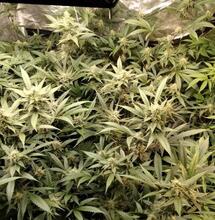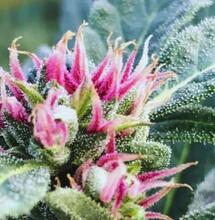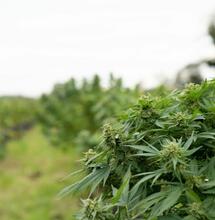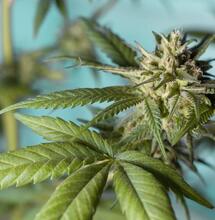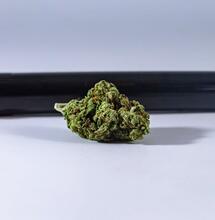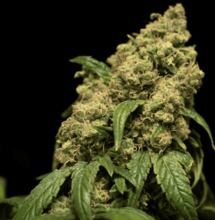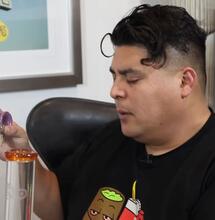Oaxacan, Angola Red and Red Lebanon
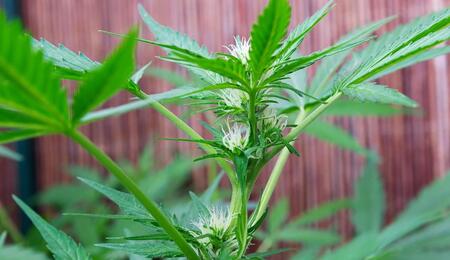
In this issue’s guide to Endangered Strains we’ll take a look at two landrace sativas, the Angola Red and the Oaxacan Highland of Mexico – and for the first time, we’ll talk about a renowned type of hashish, the Red Lebanese. All hail from parts of the world thrown into turmoil in recent years by the War on Drugs, with the traditional means of cultivation disrupted and distorted until the original and sought-after varieties have been all but lost.
Oaxacan Highland
The Oaxacan Highland pot – often known as Gold despite the beige hue to the buds (and the red calyx tips!) – used to appear fairly regularly in the US market. It was known for its strong, psychedelic high and sharp-sweet taste and smell, as well as its tall, conical growth pattern and tendency to go hermaphrodite. While the pot has all but disappeared here in the domestic market, specimens still grow in Mexico, dotted around the landscape of the hills surrounding Oaxaca City.
It usually grows to around twelve feet – quite tall for a highland variety – and its propensity to grow long, strong lower branches gives it its characteristic Christmas tree shape. The leaves are somewhat wider than many other Mexican strains, such as the Guerrera or Michoaca varieties, and the flowers are often densely surrounded by small, resinous leaves. The seeds of these and many other Mexican strains are larger, lighter in color and less mottled than most sativas of the central and south American regions.
Occasionally a few seeds thought to be original Oaxacan Highland sativa make it through, and as a result a handful of hybrid strains have been created and are available currently, such as the Eldorado from the Sativa Seed Bank and Niagara from Dr. Greenthumb. However, the likelihood of new seed stock getting through in future is ever decreasing. The level of drug-related violence in the Oaxaca region is so high that strain-hunting forays are not undertaken too often – to say the least. Added to this, the introduction of new hybrid genetics to the region has led to dilution of the lineage, as with so many other great strains, and pure examples are ever scarcer. The increase in seeds with a greater degree of surface mottling, perhaps due to introduction of Colombian genetics, is thought to be evidence of this ongoing hybridization.

Red Lebanon Hash
In Lebanon, much of the nation’s hashish production occurs in the Bekaa Valley region, which has long been controlled by cartels operating in open defiance of the law. Cannabis has been cultivated in the valley for centuries if not longer, and production often peaks at times of war and civil unrest – such as the years of civil war between 1975 and 1990, when many poor farmers made fortunes in a few short harvests. In peacetime the police and army routinely join forces, confronting the issue (and sometimes, hostile and well-armed militias) by destroying crops en masse – which is not only damaging to the local economy and the livelihoods of many, but is incredibly destructive to the landscape, often left sparse and barren after the raids.
One persistent issue is the need to invest heavily in the region’s rural development: the initial programs began in the 1990s, with the aid of the United Nations Development Program, and the intent to pour hundreds of millions into replacing the Cannabis plantations with legal cash crops. When the promised funds did not turn up, many ordinary farmers were left with no choice but to attempt to grow more Cannabis. This has been the pattern for many years – there was again some respite for the farmers in the three years following the 2006 Lebanon-Israel conflict, as authorities dealt with the more pressing matter of the war’s aftermath, but in September 2009 the eradication recommenced, and have continued every summer since.
Many Lebanese support legalization of the industry, believing that a regulated industry would be safer and economically beneficial; others feel that levels of violence and corruption are so entrenched that a heavy-handed approach is needed to eliminate such problems once and for all. The powerful families and gangs that make up the cartels constitute a powerful political voice in their own right, and many politicians resist implementing too-harsh policies in the fear of losing office, or worse, personal safety. The hash itself comes in two forms – Yellow, which is from younger plants and has a cerebral effect due to the high THC and low CBN characteristic of harvesting at this stage; and Red, which is from more mature plants, has a higher CBN content, and closely resembles Moroccan hashish (but produces a more ‘stoney’ effect).
The plants are usually stretched out to dry in the sun before being shaken over fine mesh to catch the trichomes, and the resulting powder is sealed in bags and stored until winter, when pressing will begin. The yellow form is traditionally much rarer than the red; varying qualities of both are produced, with the highest grades being extremely potent. Since the war with Israel, border controls have been very tight, and much Lebanese hash has been absorbed into the domestic market – albeit with prices suffering due to the surplus. Internationally, it is difficult to source even small quantities of good, fresh Lebanese hashish, although poor imitations abound – often from Turkey, which produces similar hashish from related varieties of Cannabis, but is generally considered to be inferior.
Angola Red
Another country where cultivation of Cannabis has been a means of subsistence for centuries is Angola in south-west Africa. The sativa landraces that grow here are widespread in the central highlands and the north-east of the country and were established prior to the Portuguese occupation, which began in 1575 and officially ended in 1975. Prior to independence (and the subsequent civil war) ships that came to the harbor at Luanda, the nation’s capital and an important trading port, could freely buy Cannabis from local traders. It seems that early Portuguese settlers may have assisted its rise to fame by transporting it to the New World; the Angolan slaves uprooted and transported to the plantations in this time may also have taken covert supplies with them. It is highly possible that many of the famous Red strains of central and south America are in fact descended from the Angola Red.
Despite the illegality of Cannabis in Angola, farmers have managed to produce crops quite consistently over the years, although here, as in Lebanon, they face the constant possibility of their crop being discovered and burned by army- and police forces. Balombo district, on the north-eastern coast of Angola, recently saw seizures of 3,500 plants in a small village called Ngolo – a significant blow for a country whose total production is rarely large enough to satisfy anything more than the domestic market.
It has been noted that the occurrence of red phenotypes has massively decreased and perhaps ceased entirely, as genetics begin to be introduced from elsewhere to supplement the losses suffered during police actions. Farmers in nearby areas, such as the Huíla province, where traditional knowledge of the properties of Cannabis has been documented among the local tribes, have been able to so far ensure that some cultivation still occurs. However, anecdotes suggest that green phenotypes pervade, and no-one really seems to know if the Red still exists.
Although Angola’s small Cannabis industry is largely deemed insignificant by the authorities, the nation’s importance as a drop-off point for cocaine has led to a crackdown on the drugs trade in general. Due to the lack of surplus harvest for export, not much Angolan Cannabis gets through to other countries (except occasional small quantities to Namibia), and the original Red is in grave danger of being truly and irreversibly lost – if it isn’t already!
The Cannabis trade in southern and central Africa is often violent and steeped in politics. As factions in the nearby countries of the Democratic Republic of Congo and Congo continue to war over control of production, Angolan authorities do not wish to appear lax as they fear the violence will begin to encroach on home ground. Although production of Cannabis is unlikely to cease altogether, the ongoing difficulties experienced by Angolan growers are so great that a historic strain may have become extinct. Without question, if any specimens of this strain are found in the future they must be preserved to ensure the lineage does not die out. Yet again, the international pot community must wait to see whether or not the powers-that-be – in Mexico, Lebanon, Angola and in the world in general – will finally wake up and realize that the continual interference in these age-old Cannabis industries is pointless and damaging, and ultimately destined to fail.
Also read on Soft Secrets:
